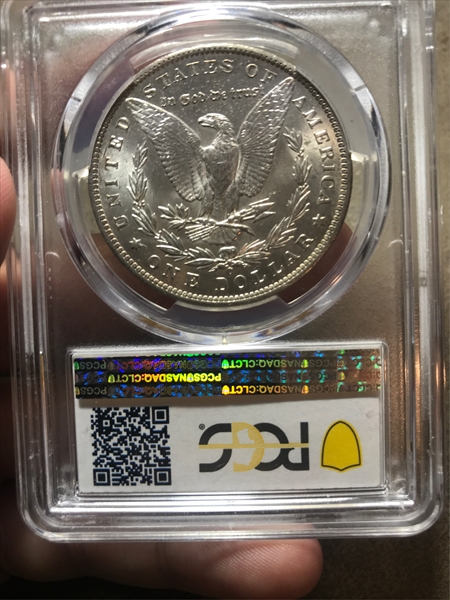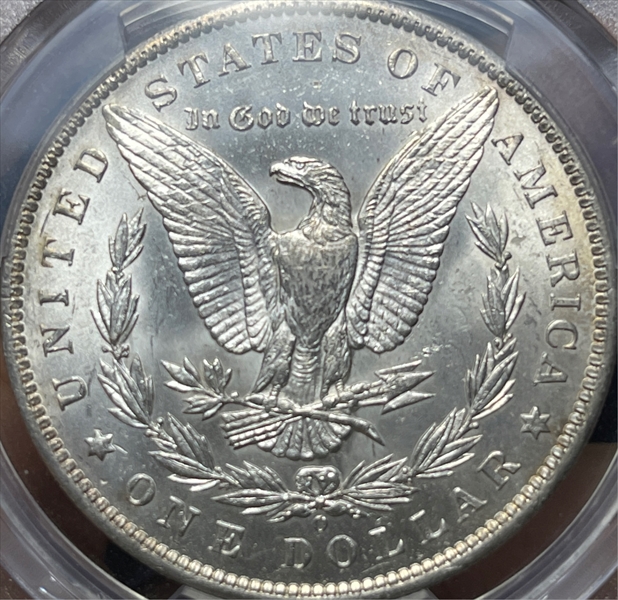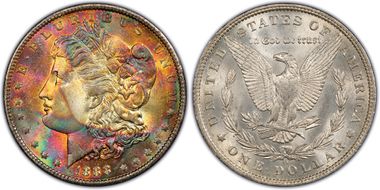1888-O $1 MS63 认证号39331892, PCGS号7184
专家评论
Q. David Bowers
The following narrative, with minor editing, is from my "Silver Dollars & Trade Dollars of the United States: A Complete Encyclopedia" (Wolfeboro, NH: Bowers and Merena Galleries, Inc., 1993)Hoard coins: Like many of its sister New Orleans issues, the 1888-O dollars dribbled out of government storage and into the coin market in small quantities in 1946 and during the 1950s, especially from about 1955 to 1957-1958. Some of these came from the Treasury Building in Washington, D.C., where they had been stored since the New Orleans Mint ceased operations. In 1957, Harry J. Forman was one of several dealers who had this issue for sale in large quantities.
In 1962-1964, many more 1888-O dollars were released from a long-stored cache in a sealed vault at the Philadelphia Mint. This additional quantity may have amounted to 100,000 coins or more, with some suggesting many hundreds of thousands, if not a million or more. Many of these were released in Montana. As an example of the quantities of 1888-O dollars on the market for a decade afterward, Wayne Miller told of buying nine original mint sealed bags of 1888-O dollars in 1971 and examining 16 additional bags in the same six week period, amounting to a total of 25,000 coins.
Concerning quantities of 1888-O dollars, John V. Kamin wrote as follows (letter to the author, October 29, 1992):
“I disagree with Wayne Miller on how many bags of these came out. I was searching for quantity lots of 1888-O all during the 1960s, and only encountered a couple of bags. I don't know of any that came out after early 1964. 1888-O was always considered a premium date of silver dollars, as evidenced by the 1963 Guide Book, where it is listed at $6.50 in BU condition, while most other "common date" silver dollars are listed at much lower prices, including some scarcer dates. I will be most pleased if 1888-O is considered a common date by Wayne Miller, and other dealers, for many more years, giving my friends a chance to buy up any bags that come on the market. I think 1888-O is at least 300 times scarcer than bags of 1883-O, 1884-O, 1885-O, and similar ‘common date’ bags!”
The following was contributed by Maurice Rosen (letter to the author, January 22,1992: (First Coinvestors [FCI], located in Albertson, New York, was headed by Stanley Apfelbaum. At one time its shares were publicly traded in the over-the-counter market. FCI published the second edition [1976] of the Van Allen-Mallis book on Morgan and Peace dollars. FCI also published Breen's Proof coins Encyclopedia and Swiatek-Breen on commemoratives, and negotiated with Doubleday for publication of Breen's Complete Encyclopedia of U.S. & Colonial Coins (1988). A few years later both FCI and Stanley Apfelbaum were dead, having forever changed numismatics with these books.)
“One of my duties at First Coinvestors was to manage and acquire coins for our U.S. Silver Dollar Investment Program which at its peak in the mid-1970s had about 1,000 active investors. I recall handling bag quantities of these New Orleans issues. By today's standards, they were all in low Mint State grades, MS-60 to MS-62, almost always softly struck, with not one coin making even today's 64.”
Circulated grades: Circulated 1888-O Morgan dollars are very common in all grades up through and including AU-58. Mint State grades: This issue is very plentiful in Mint State, particularly in grades from MS-60 to MS-62, of which 100,000 to 200,000 are believed to exist, although this estimate may be on the low side-particularly if the Philadelphia vault hoard was larger than thought. MS-63 coins are plentiful. MS-64 coins are also common, perhaps to the extent of 20,000 to 35,000 coins. At the MS-65 level, the 1888-O is slightly scarce, with an estimated population of 4,000 o 8,000 pieces.
The strike of 1888-O dollars varies from weak to sharp but is usually average to weak, with average to dull lustre. Cherrypicking is advised to acquire sharp specimens.
Prooflike coins: The 1888-O is one of the most plentiful Morgan dollars with deep mirror prooflike surface and with cameo contrast, although most are below the MS-65 DMPL level (thus raising questions of aesthetics for the majority of coins encountered). The 9,000-piece (nine bags) hoard described by Wayne Miller (and mentioned above) contained approximately 1,300 prooflike pieces of which at least 500 were deep mirror cameos. The same author noted that in the 1970s numerous other hoards of 100 or more prooflike pieces came on the market, causing prooflike coins to be overrated on the market by 1982 the date of Wayne Miller's book).
Die rotation: VAM-9 exists with the reverse die rotated from 300 clockwise to 1750 counterclockwise from the normal orientation.
Varieties
Circulation strikes:
1. Normal issue: Probably over 50 pairs of dies were used to coin 1888-O dollars. Thus, there are numerous positional variations, both obverse and reverse. There are two distinct styles of mintmark: Oval-O (slit opening), Breen-5601, four varieties listed by VAM, each seemingly much rarer than supposed;(Letter from Jeff Oxman to the author, November 29, 1992.) Round 0 (wide opening), Breen-5602, VAM-1.
2. Double lips, also called "Hot Lips": Doubled obverse die, actually the strongest in the series (per V AM), discovered as a cherrypick by Chester Bryk (1962). VAM-4, Breen-5603, F&S $1-006. Very scarce. Usually in low grades (below EF-40). No high grade Mint State coins have been seen by VAM or Walter Breen Jeff Oxman reported:" "Two DMPL specimens have come to light since 1990, an EF-45 and an AU; prior to these discoveries, no specimens with even a trace of prooflike surface had been known." Fivaz and Stanton call it "R-6" in AU and "at least R-7" Uncirculated, specifying that they had seen only one, a coin graded MS-60. Later die states (first reported by Kenneth B. Embler) show obverse cud breaks, 5:00-7:00, later still also 12:00-2:00 (Cf. Error ariety News 1/30/79, page 6).
3. Doubled reverse die: VAM-9. Doubling plain on right wreath, ERICA, ONE DOLLAR, tail feathers, arrow shafts, etc. VAM-12 and 15 also show doubling on the reverse.
Dies prepared: Obverse: Unknown; Reverse: Unknown.
Circulation strike mintage: 12,150,000; Delivery figures by month: January: 1,000,000; February: 1,000,000; March: 1,200,000; April: 1,200,000; May: 1, 100,000; June: 750,000; July: 600,000; August: 1,000,000; September: 1,200,000; October: 1,000,000; November: 1,000,000; December: 1,100,000.
Estimated quantity melted: Probably millions under the 1918 Pittman Act and later legislation; many worn coins during the run-up in silver prices of the late 1970s.
Availability of prooflike coins: Very plentiful, probably on the order of 5,000-10,000 (URS-l4). DMPL coins are less plentiful and are mostly below MS-65.
Characteristics of striking: Most coins are lightly struck at the centers; probably 80% to 90% have this characteristic. However, sharply struck coins exist.
Known hoards of Mint State coins: Hundreds of thousands, if not a million or more, were released by the Treasury 1962-1964. Wayne Miller (1982, p. 9) mentions examining 25,000 Mint State coins in eastern Montana in the 1970s.
Commentary
The 1888-O is common in Mint State. Most pieces are flatly struck. Notable for the most spectacular doubled die obverse in the entire Morgan series, indeed one of the most spectacular in the whole United States series. Its closest rival is the 1955 cent.
PCGS #
7184
设计师
George T. Morgan
边缘
Reeded
直径
38.10 毫米
重量
26.73 克
铸币数量
12150000
金属成分
90% Silver, 10% Copper
更高评级数量
14044
评级较低的钱币数量
4350
地区
The United States of America
价格指南
PCGS 数量报告
拍卖 - PCGS 评级的
拍卖 - NGC 评级的
稀有性和存量估计 了解更多
| 所有评级 | 1150000 |
| 60或以上 | 280000 |
| 65或以上 | 7100 |
| 所有评级 | R-1.0 |
| 60或以上 | R-1.8 |
| 65或以上 | R-3.5 |
| 所有评级 | 94 / 117 TIE |
| 60或以上 | 89 / 117 TIE |
| 65或以上 | 82 / 117 |
| 所有评级 | 94 / 117 TIE |
| 60或以上 | 89 / 117 TIE |
| 65或以上 | 82 / 117 |




























